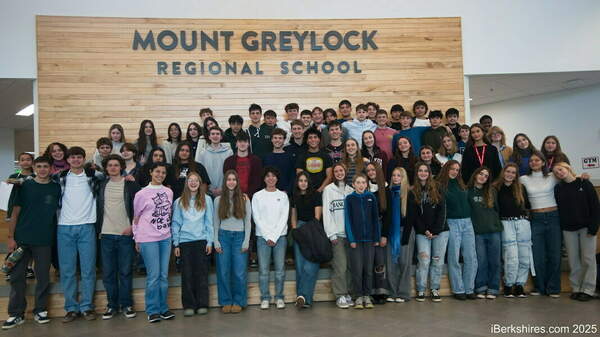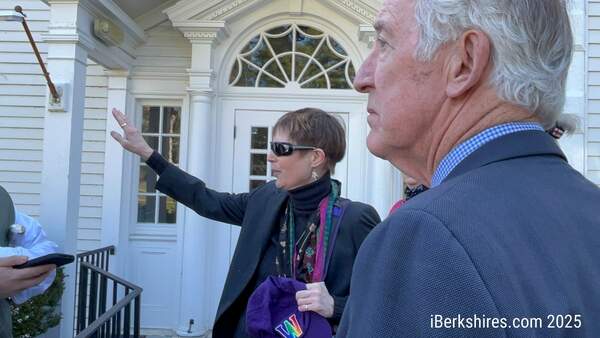Local Reactions Continue Over Hospital's Closing
 NAAS General Manager John Meaney Jr. told the City Council that turnaround time for an ambulance going to Pittsfield or Bennington, Vt., was 90 minutes to 2 hours, while transporting to North Adams kept a vehicle out of service for 15 to 20 minutes. NAAS General Manager John Meaney Jr. told the City Council that turnaround time for an ambulance going to Pittsfield or Bennington, Vt., was 90 minutes to 2 hours, while transporting to North Adams kept a vehicle out of service for 15 to 20 minutes. |
NORTH ADAMS, Mass. — Thirty years ago, Michael D. Wilber was protesting "midnight movers" like X-Tyal that closed their doors in the middle of the night, leaving employees out in the cold.
Now he wants the community to rally to keep the doors open at North Adams Regional Hospital.
"The only way we can fight this outrage is to show up," the former union leader said Tuesday night, calling for an "occupation" of the facility on Friday morning and handing out posts for people to get in touch with him.
The April 4th Coalition and other groups are also involved in the rally, timed to begin before the emergency room's expected closing at 10 a.m. A White House petition has also been started.
"If you want do anything, you have to fight. If you don't get hundreds of people, it means they really don't care," Wilber said. "If people want it to be open, they've got to be willing to fight to keep it open."
But how to keep the hospital operating continues to be a question mark for the troubled health care system that has struggled with millions of dollars of debt for years even as revenues continued to drop off.
"It's impossible for organizations of our size to survive on our own in the future and I think that's unfortunate, as sorry as I am to see this day come," President and CEO Timothy Jones told WNYT. "I think it's an unfortunate circumstance and you'll probably see other hospitals in the state go through the same thing."
Jones has said the aging population and the area's high poverty level were factors in the health care system's ability to survive.
Some 530 employees ranging from clerical workers to maintenance to registered nurses to doctors will be without jobs by next week; most will be done by Friday.
Jane Allen, who serves on the board of trustees, declined to comment on the closure.
In a letter to staff obtained by The Berkshire Eagle, the trustees wrote that "today's news was unthinkable."
"Everyone in the organization, along with our state and federal legislators, has been working to avoid this outcome. In the end, as revenues declined precipitously it was simply impossible to continue operations. We had hoped for purchase by another party, but our financial position quickly weakened it became clear that we could not complete a sale."
Local legislators are hoping to stave off the closure through state or federal intervention. The hospital's two unions, 1199SEIU and the Massachusetts Nurses Association, are also protesting the closure.
"It's a total disaster. It's not just affecting seniors. It's affecting the 530 people who lost their jobs. What happens to them?" said Brian O'Grady, director of Williamstown's Council on Aging. "Every week we bring whole bunches of people up there for blood tests, the Wound Clinic, the eye doctor, whatever."
"It feels like a death or worse," said City Councilor Jennifer Breen on Tuesday as councilors weighed in on the shocking news from earlier in the day.
Councilor Nancy Bullett, who worked at the hospital for 17 years, choked back tears, but cautioned residents to contact their doctors or insurance carriers for more information on whether they will be covered at other hospitals.
"We all live in a world where our insurance carriers decide what we do," she said.
John Meany Jr., general manager of North Adams Ambulance Service, informed the City Council that his team will be meeting with the state Department of Emergency Services, local emergency services and North Adams Regional Hospital, Berkshire Medical Center and Southern Vermont Medical Center to determine the best course of action.
The ambulance service recently voted to acquire a fifth ambulance, which would allow it to staff more than three at a time.
That will be critical because of the increased turnaround time — it takes 1 1/2 to 2 hours to transport to BMC or SVMC.
"Turnaround the time will be significant," said Meaney. "North Adams was 15 to 20 minutes."
Mayor Richard Alcombright said he had had "a good conversation with the governor."
"He pledges to do whatever he can to try to bring a positive outcome to this," he said. "Until I hear that nothing can be done ... it's not closed."
If it is a done deal, the community has to figure out what health care will look like in the future, he said. "It cannot be a 30 to 60 minute trip to BMC. It has to be more than that."
Councilor Wayne Wilkinson said his wife, a nurse at the hospital for 32 years, had lost her job.
"I want to thank them for all the services, when we needed help they were there," he said of the hospital's staff. "I always was treated excellently. ... They've always done a great job."
Tags: ambulance service, hospital, NARH, NBH, North Adams ambulance,















